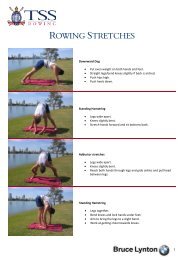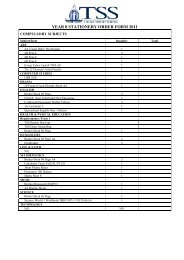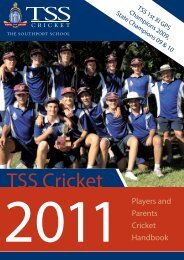Admissions Handbook 2011 - The Southport School
Admissions Handbook 2011 - The Southport School
Admissions Handbook 2011 - The Southport School
Create successful ePaper yourself
Turn your PDF publications into a flip-book with our unique Google optimized e-Paper software.
<strong>Admissions</strong> <strong>Handbook</strong> 27<br />
Boys’ Education<br />
Meeting Contemporary Challenges in Boys’ Education<br />
With all the new research and growing number of ‘experts’ in the field, you would think modern parenting<br />
would be somewhat a breeze.<br />
Nothing could be further from the truth.<br />
Finding ways to successfully navigate your family through the complexities of modern living while often<br />
juggling additional responsibilities can be a challenge.<br />
However, when your child’s school is active in discovering, interpreting, evaluating and presenting the latest<br />
research and methodologies, the way forward can suddenly become very clear.<br />
TSS, under the Headmastership of Greg Wain, is such a school. Greg’s keen professional and personal<br />
interest in matters relating to the education and raising of children, particularly boys, gives parents a clear and<br />
straightforward presentation of what works and what doesn’t and why.<br />
Since his arrival at TSS nearly five years ago, Greg has offered primarily new parents the opportunity to<br />
attend one of his Boys’ Education Information Sessions in which he discusses the need for boys’ education<br />
which is focused on what works best for boys.<br />
However, he also has recognised the need for current parents to renew their thoughts on raising their sons<br />
based on this new brain research and these sessions have now been extended to include all parents.<br />
Many parents, after hearing Greg’s presentations, have been pleasantly surprised at how simple some of the<br />
techniques are which help with raising children, particularly in the adolescent years.<br />
“Often Mum and Dad attend together and several couples have remarked it is the best marriage guidance<br />
counselling they have received! This comes from the research showing the hard wiring and developmental<br />
differences between boys and girls as well as men and women – men are not hopeless, just different!” said<br />
Greg. “When these differences are understood, men and women are better able to see various strengths and<br />
challenges.<br />
“<strong>The</strong>re are a number of physical brain differences which we are only now beginning to appreciate courtesy of<br />
the advancements in diagnostic equipment,” said Greg.<br />
Historically, much scientific research on brains was done after the subject was usually advanced in years and<br />
deceased. Advancements in technology mean that brains can now be studied during the subject’s lifetime with<br />
age comparisons made using the same subject.<br />
“Already basic differences are showing boys and girls are very different, not just in terms of their<br />
development, but also in how as men and women we perceive and interact with and within the world.<br />
“For example, physical differences in the formation of the cochlea mean boys do not hear as effectively as<br />
girls. Female teachers need to talk relatively loudly, certainly louder than they might perceive is necessary, in<br />
order to be heard by boys. On the plus side, boys are 10 times less likely than girls to be distracted by<br />
extraneous noise. This means girls prefer a quieter learning environment while boys can ‘tune out’<br />
superfluous noise quite effectively. This probably explains why males are so good at watching the television<br />
and not being distracted by anything else happening in the house at the same time!”<br />
Using the example of pre-school aged children, Greg highlights another major difference between boys and<br />
girls, which emerges at quite a young age.<br />
“Girls will see ‘what it is’ so if you ask them to draw a picture of their playground they will fill it with details<br />
such as colours, flowers, swings, toys and other children. On the other hand boys see ‘where is it in space’ and<br />
try to capture the motion of the scene. This typically leaves you with a ‘pretty’ picture by the girls while the<br />
boys often present a picture with very little use of colour but lots of lines to represent movement. Both<br />
drawings are valid yet show the difference in our ‘hard-wiring’.<br />
“I strongly hold the belief that teachers who understand these differences will be more effective in the<br />
classroom particularly in an all-boys’ environment such as TSS.”<br />
Greg says dealing with teenage boys can be more successful when techniques, which take into account the<br />
differences between males and females, are used.
















